
Colt Pistol Picture Dump




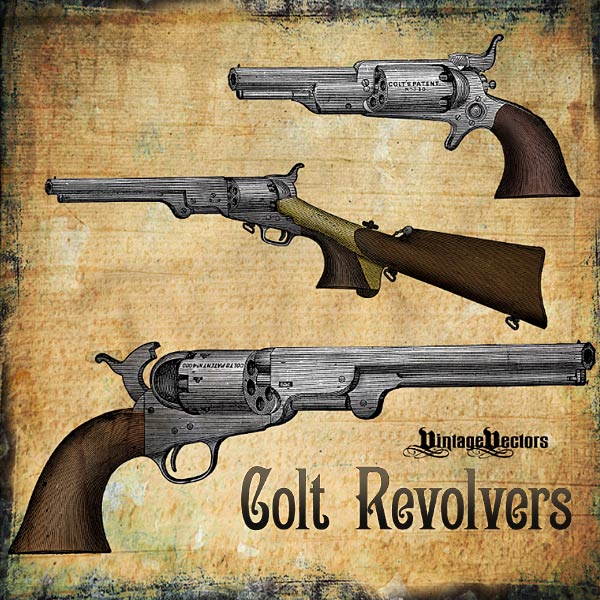
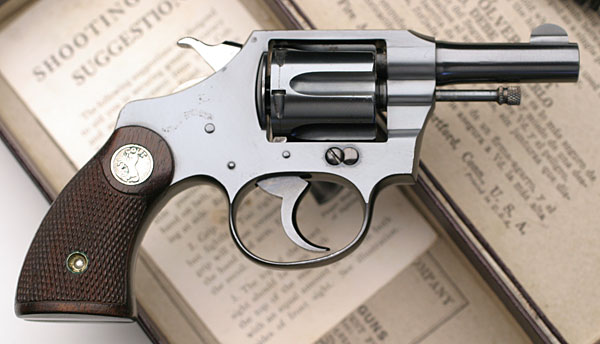

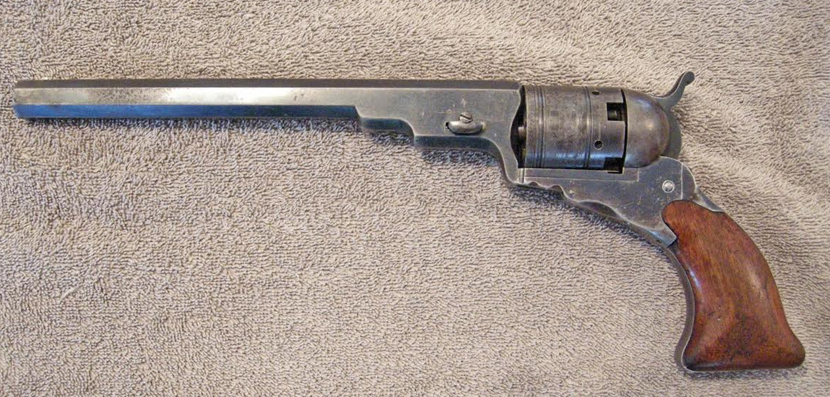



Just because! NSFW

Model 1903 Springfield Myths
Please take this one with a huge grain of salt!
Grumpy

Winchester Pre 64 62a 22 LR
A Primer On Deer Hunting
| November 4, 2014
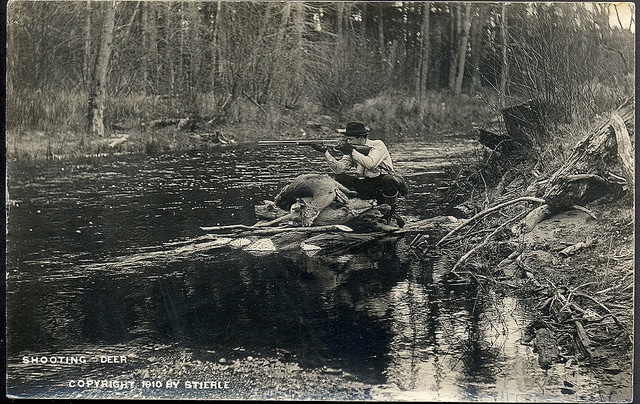
Editor’s note: This is a guest post from Josh Cantrell and Kevin King.
The hunting of various species of wild deer has been a national passion and tradition for countless generations. Many Native American stories and accounts are riddled with the hunting and harvesting of whitetails. The Pilgrims of Plymouth Plantation, in addition to numerous waterfowl and turkeys, harvested deer or “venison,” as was documented by William Bradford in his journals. Many early explorers of the West found whitetail and mule deer to be a bountiful, necessary food source for themselves and their families. Unfortunately, the 20th century saw a sharp decline in the harvesting of deer due to overhunting and a decreasing population of whitetail throughout the United States. However, due to the diligent efforts of state conservation departments and responsible hunters, many states now boast close to 200,000 or more harvested deer each year. In fact, in many states deer are overpopulated and are threatening forest growth and farms and may also increase the risk of lyme disease in humans in areas where their numbers are particularly high. Responsible hunters play an important role in managing deer populations so the herds don’t stress ecosystems.
Your may have found yourself considering deer hunting at one time or another but never really knew where to start. The advantages of deer hunting are numerous:
- Fresh, organic, lean meat
- Time spent in nature
- Cultivated survival/outdoorsman skills
- Personal growth as a man/provider
- Character development
- Marksmanship
- Tradition
With this primer on deer hunting, and some practice and mentoring from experienced hunters, you should be able to take to the woods with confidence in pursuit of your first in a long and happy series of deer.
Choose Your Weapon

The first place to start with deer hunting is to decide your method. Do you want to be a rifle hunter or do you want to be an alternative methods hunter (bow, atlatl, pistol, etc.)? Many of us began as rifle hunters because it is the most accessible place to start. Since this is a beginner’s primer on deer hunting, we would recommend starting with a rifle and then branching out as your interests dictate.
When choosing a deer rifle, one must take budget and fit into account. When I recently spoke to Ken Jorgensen at Ruger Firearms he recommended that a hunter finds a rifle that:
- Completes the task effectively (in this case, kill a deer quickly)
- Fits the shooter
- Can be shot well
It is worth your time and efforts to go to a gun store and “try out” potential rifles. Pick up the guns, shoulder them, manipulate the actions, sight-in an object on the floor or ceiling, and just see how you like them. A few models of guns to look into as a budget-friendly starting point are:
- Winchester Model 70
- Savage Trophy Hunter XP
- Weatherby Vanguard
- Remington Model 700
- Ruger American Rifle
To complete the task effectively in deer hunting requires a cartridge with a little punch. However, if you are unfamiliar with gun calibers, choosing the best caliber for yourself is like choosing some random battery off the shelf and hoping that it will work in your TV remote. You need the proper amount of power combined with your ability to manage recoil. A few common calibers for deer hunting are as follows:
- .270 Winchester
- .308 Winchester
- .30-30 Winchester
- .30-06 Springfield
- 7mm Remington Magnum
All of these calibers are favorites amongst deer hunters and outdoorsmen. If you can, try to shoot these calibers before you buy one to see which you like; each cartridge almost seems to have its own personality. If you cannot shoot before committing to a rifle, read and watch as many reviews as possible to educate yourself on their uses. If you choose an adequate caliber and the gun fits you well, you have won 2/3 of the battle. All you have to do now is practice.
A great place to start when practicing is to shoot from a bench towards a stationary target, placed at 25 yards. You want to work on placing groups on the target that are all striking near the same position. Then, as you get more familiar with the gun, move your target out to 100 yards and work on the same thing. A 100-yard shot is a good place to begin as a first-time hunter. As you get more familiar with the gun, you will be able to work out to farther shot placements. However, for your first, 100 yards is a respectable distance.
Hunter’s Safety Course
Once you have acquired the gun and skills required to hunt efficiently, there is one final step of the process: becoming certified and licensed by your state conservation department. Regulations on becoming licensed vary from state to state. Most states require anyone who wishes to legally hunt with a firearm to take a hunter’s safety course. The requirements of the course, including the age at which one must be licensed, varies from state to state. The best source for this information would be your state conservation department website or a nearby conservation office.
Most hunter safety courses include a 4-hour course and a written exam. You can study for the exam online or with an instruction booklet provided by your conservation department. Then, once you have prepared for the class, simply register for your 4-hour certification course online or in person. Most of these classes are free of charge. Once you have passed your test and received certification, you are now able to purchase your permits for your hunt.
If you are not sure yet if deer hunting is for you, you might look into a short-term alternative to acquire your hunter permits. In many states, there are hunter apprentice programs that allow you to take to the field alongside another certified hunter that has completed their hunter’s safety course. This allows you to buy permits and hunt in this manner for a brief time before you take a hunter’s safety course for yourself. That way, you can decide if it is a good fit for you.
Before taking to the field, it is important to read your state’s hunting regulations thoroughly each and every year that you hunt. These regulations, due to management needs, can change annually.
Dressing for the Field
The next step is to outfit yourself with hunting gear. This is where a hunter can really lose themselves in the influx of scents, camos, and various other products that supposedly offer unlimited success. Here are the bare-bones necessities when you head into the woods on your hunt:
- Your gun
- Blaze orange hat and vest (wear this 100% of the time – it can save your life)
- A box of ammunition (unless you shoot and miss a lot, this should suffice)
- A good, sharp knife (for field dressing your deer)
- Tall rubber gloves (for field dressing your deer)
- A flashlight (for tracking your deer)
- Warm gloves, hat, and jacket (for those cold November hunts)
- Your permits (the most essential item)
- A ziplock bag, zip tie, and a pen (depending on your state laws for tagging your game)
Finding a Place to Hunt

Once you have procured all of your essentials and are now a proficient marksman, the next step is finding a place to hunt. If you are a landowner with enough land to hunt, you are in luck. If not, you need to either find some public hunting land in your area or become friends with some of your local farmers and landowners. Never hunt somewhere that you have not obtained permission to hunt. Build a good relationship with those kind enough to let you hunt and, if you are blessed with a harvest, share a portion of it with your host.
When you find land, either choose a location in a wooded area that allows for deer and other animals to pass by, or choose to hunt the edge of an open field. This is where pre-season scouting becomes very important. When hunting for the first time, we recommend hunting from ground level, but if you prefer a stand, make sure you choose one that is stable and easy to climb into with a rifle and your gear. These types of stands are called tripod stands and can be found at your local outdoor stores. These stands increase the cost of your hunt dramatically, so decide whether a stand is necessary before making the investment. The advantage to hunting out of a stand is that you are not eye level with the deer so it is harder for them to see you.
You want to make sure that your stand or ground location is along a path that deer travel frequently. Another thing that you should consider when picking your stand or hunting spot is your comfort level. If you are not able to consistently make long shots, an open field is not the place for you. You should try setting up in some hardwoods where the only shot that you can take is a close one. Make sure you arrive to your hunting location before sunrise or a few hours before sunset, so as to minimize your presence. Then, patiently wait for your game to arrive.
One way to increase the odds in your favor is to put out a salt lick, a food plot, or other attractants near your hunting spot before the season opens. These attract deer, as well as other wildlife, and make your hunting location part of their regular routine. One thing to consider when doing this, however, is the potential requirement to discontinue your attractants before the season (normally 10 days prior). Otherwise, you may be dealing with a baiting violation and a huge fine. If you take this step, be aware of all of the responsibilities involved and take the necessary precautions to ensure an ethical, legal hunt. Every state is different, so check your state’s laws about food plots and baiting. When trying to decide what would work best for you, think through your hunting situation and commitment level. It takes time, land, and discipline to plant and maintain a plot. Make sure that you are ready to make that commitment of both time and resources.
Taking the Shot
When taking a shot, you always need to wait for a deer to stand broadside, which means that they are standing perpendicular to your rifle barrel. When you can see from nose to tail, bring your sights onto the deer just behind the front shoulder, as you want to hit the lungs and/or heart. Quietly take the gun off safety, take a big breath and let it out, and evenly squeeze the trigger until the gun fires. Immediately, rack the bolt and chamber a live shell.
If you have hit your mark, watch where the deer takes off. Wait anywhere between 15 and 30 minutes before tracking and pursuing. This will give the deer plenty of time to lie down and expire. If you try to chase the deer as soon as it is shot, you are going to place unneeded stress on the animal. This will also cause more adrenaline to be produced by the deer, which will make it travel farther. The additional surge of hormones and chemicals can potentially result in your venison developing a strong “gamey” or undesirable flavor. If the deer has crossed a property line, make sure that you have permission to be on that property before pursuing. It is still considered trespassing if you are chasing a wounded animal. Make sure you know who owns all of the land around you and how to get in touch with them. It’s your responsibility to make every effort to recover any deer you shoot.
Following the Trail
To track your deer, go to the location where you think your shot connected with the animal. When you reach that location, look for the tell-tale signs of a wounded animal: ground severely torn by hooves, tufts of hair, bone fragments, and most of all, blood. At this point, many hunters put down an object, such as a hat, next to the first hint of a trail. Do your best to look for a trail of any of these materials on the ground and follow it to find your deer. If the blood becomes more plentiful, you are on the right track. If, at any time, you lose the trail, go back to the last point where you had a clear trail and track it again. Taking a buddy or a group of other hunters to help track a difficult trail can be the difference between an animal harvested and an animal wasted. (You might also consider hunting with a canine companion.)
When you come upon your deer, do so with a loaded gun, ready to put your game down if it is not yet expired. Once you have determined that your animal is down, take a moment to pat yourself on the back and breathe a sigh of successful relief. After that, it’s time to get to work.
After the Shot
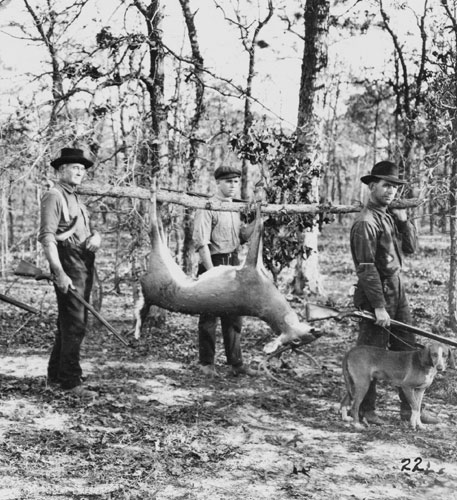
Before dressing your game, make sure you first tag your deer. Follow the methods of tagging your game that are required by your conservation department, to the letter. Some states have you attach the permit to an antler, others have you place it in a plastic bag around the leg, and others have you tag the animal via smartphone. Make sure you are familiar with and prepared for the tagging procedures before you are out in the field.
Methods for field dressing a whitetail are varied and everyone thinks that their way is the right way. Therefore, while there are a few “essentials” when dressing a deer, to get a more specific how-to, I recommend looking at videos online or reading the literature given out by state conservation organizations.
The standard way to field dress a whitetail begins with a long incision (blade facing up) between the pelvis and the sternum, making sure not to nick the internal organs. Remove exterior genitalia and discard before cutting in a circular motion around the anus. With a short length of string, tie off the lower intestines and bladder inside the body cavity before rolling the deer over on its side to empty the contents. Some cutting will be needed to free the organs from the back. Then, cut through the diaphragm (some people split the rib cage here, as well), remove the lungs, heart, and the windpipe as high as you can reach. Then, turn your deer over one more time to drain any remaining blood left in the cavity.
At this point, you can take your deer to a meat processor and they will work up the deer for a fee. However, if you want to work it up yourself, get the deer someplace where it can be hung upside down and drained out for a few hours before quartering and butchering it, much like you would a cow. If you are doing the self-butchering method, we also recommend getting a grinder, a group of people to help, and a lot of food-saver vacuum bags. Lastly, make sure you clear out a nice big spot in the freezer for all of the great meat you are going to enjoy for months to come.
Ethics in the Woods
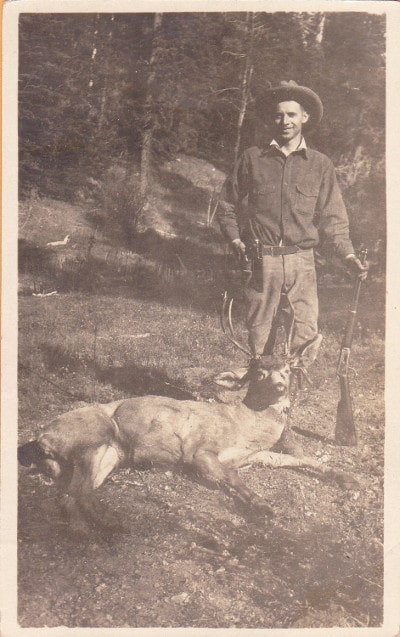
When going out in the woods in search of deer it is important that you maintain a high ethical standard of behavior. One of the best ways to do this is to practice with your weapon of choice. The more confident you are with your weapon, the more humane you will be to the deer.
Treat all the land with respect. Anything you pack in, make sure you pack it out. Unfortunately, there are hunters out there that are not interested in cleaning up after themselves. If you come upon trash (shell casings, food wrappers, discarded scents, etc.), pack out that trash as well, even though it is not your own. The more we all work to take care of our natural resources, the longer it will be there to enjoy. Make sure that safety is always at the forefront of your thinking when hunting, even if you are hunting alone. Accidents can happen when you are by yourself, so always be overly cautious and ensure that safety rules are being followed.
Lastly, don’t allow yourself to get too caught up in the technical aspects of the hunt that you forget to enjoy the experience. Deer hunting is a fun, challenging, exciting, and character-building way for you to feed your family while maintaining a tradition that spans far beyond the history of this nation and its inhabitants.
___________________________
Josh Cantrell and Kevin King are avid outdoorsmen, fishermen, hunters, and teachers in southwest Missouri.
Sociologists and criminologists rendered their verdict. Gun-control in California doesn’t work. In hindsight, that should have been obvious. Unfortunately, these failed laws will probably not be rescinded by lawmakers nor be overturned by judges. Since Californians won’t change things at the ballot box, they are going to have to vote with their feet to restore their rights.
What we now know about gun-control-
This recent report on gun-control was issued by a number of academics, including the researcher funded by the state of California in their Violence Prevention Research Program. This is hardly a right wing policy piece purchased by gun manufacturers. The report compared data from California with data from other states that did not enact gun-control laws. Rates of homicide with a gun and suicide did not decrease in California compared to those other states used as a control group. There was no significant difference despite the gun-control laws being in place for more than a quarter century. Mandated background checks for all firearms purchases didn’t reduce crime or suicide. Prohibiting people with misdemeanor offenses from buying guns didn’t reduce crime or suicide in California.
California also has mandatory firearms safety training, 10 day waiting periods, magazine capacity restrictions, and one-gun-a-month purchase restrictions. Most people can’t get a concealed carry license in California. There are obvious reasons these gun-control laws don’t work despite the political promises made in press releases.
What we thought would happen and why gun-control failed-
California politicians said that criminals wouldn’t use guns if we regulated law abiding citizens. In most cases, the criminals simply got their guns illegally. If guns were in short supply, then criminals shared guns rather than each criminal having a gun of his own. For the few criminals that were inconvenienced by these gun-control laws, the criminal simply used another tool of intimidation rather than using a firearm.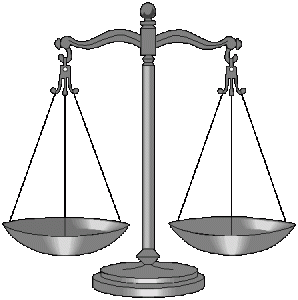
That analysis only looks at part of the balance between criminals and crime victims. It has to be true that some criminal somewhere was inconvenienced by California’s gun-control laws. Unfortunately, all of the law abiding California gun owners were also inconvenienced by these laws. Many honest citizens were disarmed. The effect of disarming a few criminals was overwhelmed by disarming so many of the intended victims of crime. Rather than make crime harder, California’s gun-control laws made crime easier. Guns save lives when they are in the hands of law abiding citizens as well as take lives when they are in the hands of criminals.
This study shows that criminals ignore gun laws and the burden falls on honest gun owners. That is true for every gun-control law. Unfortunately, California politicians and judges don’t care. There is a reason why.
We are the only ones who care if gun-control fails-
California’s gun-control laws clearly infringe on our natural right of self-defense. These laws also disproportionately disarm the poor and minority segments of our society. Gun-control leaves the most vulnerable segments of society at greater risk. Shouldn’t lawmakers and judges care about that?
California’s gun-control laws don’t apply to California politicians. They can buy the guns they want and carry them at times and places where you can’t. California judges get concealed carry permits in counties where ordinary citizens are denied a permit. In addition, California politicians can continue to rake in campaign contributions in support of gun-control even though the gun-control laws don’t work.
In short, gun-control works for California’s elites. Politicians and judges won’t change a system that works for them. What is shocking to me is that federal court judges agree with the California politicians and with lower court judges. That means we can’t look to politicians or judges for help.
Changing things is up to us.
~_~_
I gave you 600 words for free. Please rate, share, and comment in return. RM
I think that the Term – A Death by a thousand Cuts comes to mind! Grumpy

U.S.A. -(Ammoland.com)- In a split decision, a three judge panel at the Third Circuit Court of Appeals effectively ruled the Second Amendment of the Bill of Rights is a second-rate right, not entitled to the full protections of other enumerated rights. The opinion was filed on 5 December, 2018. The case is Association of New Jersey Rifle and Pistol Clubs, Inc. v. Attorney General New Jersey, No. 18-3170 (3rd Cir. 2018).
The two majority judges followed the trend of other Circuits where the Second Amendment is being degraded and reduced to second-rate status. Only a month ago, the First Circuit ruled the Second Amendment does not apply outside of the home.
The rogue Circuits are able to do this because the Supreme Court has been refusing to hear Second Amendment cases for nearly a decade. The Supreme Court only hears a limited number of cases. They are not required to hear all cases.
Some Circuit courts are gutting the Second Amendment by claiming it is not really a right. Rather, they say, it is a privilege the government may regulate if the government thinks it might do some good to regulate it. These Jurists seem embarrassed by the Second Amendment. They seem to believe their job is to limit it as much as possible, rather than to protect it as a fundamental right.
Judge Stephano Bibas wrote the dissenting opinion in the Third Circuit ruling. He is an outstanding jurist who was appointed by President Trump. At only 49 years old, he is already the 15th most cited jurist by the Supreme Court. His resume is impressive. It is easy to see why President Trump chose to appoint him. His dissent runs to 19 pages. The first four paragraphs eviscerates the majority decision. From uscourts.gov:
The Second Amendment is an equal part of the Bill of Rights. We must treat the right to keep and bear arms like other enumerated rights, as the Supreme Court insisted in Heller. We may not water it down and balance it away based on our own sense of wise policy. 554 U.S. at 634-35.
Yet the majority treats the Second Amendment differently in two ways. First, it weighs the merits of the case to pick a tier of scrutiny. That puts the cart before the horse. For all other rights, we pick a tier of scrutiny based only on whether the law impairs the core right. The Second Amendment’s core is the right to keep weapons for defending oneself and one’s family in one’s home. The majority agrees that this is the core. So whenever a law impairs that core right, we should apply strict scrutiny, period. That is the case here.
Second, though the majority purports to use intermediate scrutiny, it actually recreates the rational-basis test forbidden by Heller. It suggests that this record favors the government, but make no mistake—that is not what the District Court found. The majority repeatedly relies on evidence that the District Court did not rely on and expert testimony that the District Court said was “of little help.” 2018 WL 4688345, at *8. It effectively flips the burden of proof onto the challengers, treating both contested evidence and the lack of evidence as conclusively favoring the government.
Whether strict or intermediate scrutiny applies, we should require real evidence that the law furthers the government’s aim and is tailored to that aim. But at key points, the majority substitutes anecdotes and armchair reasoning for the concrete proof that we demand for heightened scrutiny anywhere else. New Jersey has introduced no expert study of how similar magazine restrictions have worked elsewhere. Nor did the District Court identify any other evidence, as opposed to armchair reasoning, that illuminated how this law will reduce the harm from mass shootings. Id. at *12-13. So New Jersey cannot win unless the burden of proof lies with the challengers. It does not.
If the Supreme Court grants a writ of certiorari (the legal term for agreeing to hear a case before the Supreme Court), Judge Bibas’ reasoning is rock solid.
For those who do not follow these cases closely, here is a short explanation of the different levels of scrutiny.
Strict Scrutiny – The highest level of protection, reserved for fundamental Constitutional rights. To pass this level of legal examination, a law, regulation, or other restriction of a Constitutional right must be required by a compelling state interest, and the restriction must be narrowly tailored to achieve that result. The burden of proof is on the government.
For example: There is a general prohibition on shouting “Fire” in a crowded theater, when there is no fire. This is a restriction on the First Amendment right of freedom of speech. The prohibition serves a compelling state interest of public safety. The restriction is narrowly tailored to ban shouting false information that causes severe, direct, physical, harm to others.
A corollary for the Second Amendment would be a general prohibition on firing a gun in a crowded theater when there is no reasonable, deadly threat.
Intermediate Scrutiny- The middle level of protection of less than fundamental rights. The law or regulation must serve an important government objective, and be substantially related to achieving that objective. The burden of proof rests with the government. This level is fairly new, only existing since 1976.
Rational Basis – The lowest level of protection. Generally not applied to rights. It essentially is no protection at all. The party challenging the law or rule has the burden of proof. They have to show the government has *no* legitimate interest in the law, rule, or policy. They have to show there is *no* conceivable rational basis for the law, even if the government never stated one. Laws, rules, or policies are almost never struck down on this basis.
Judge Bibas shows the two majority judges collapsed the level of scrutiny from strict scrutiny to rational basis, while calling it “intermediate scrutiny”.
Second Amendment supporters know the Third Circuit ignored the rule of law and applied their own, cherished, leftist, Progressive, biases to gut Second Amendment protections in this case.
Judge Bibas, in his masterful dissent, shows how they did it.
About Dean Weingarten:
Dean Weingarten has been a peace officer, a military officer, was on the University of Wisconsin Pistol Team for four years, and was first certified to teach firearms safety in 1973. He taught the Arizona concealed carry course for fifteen years until the goal of constitutional carry was attained. He has degrees in meteorology and mining engineering, and recently retired from the Department of Defense after a 30 year career in Army Research, Development, Testing, and Evaluation.
